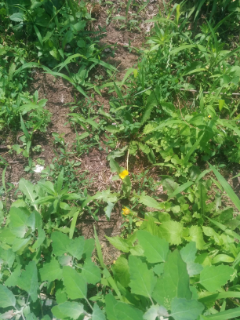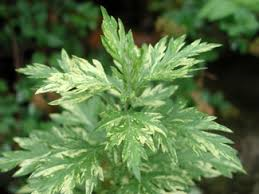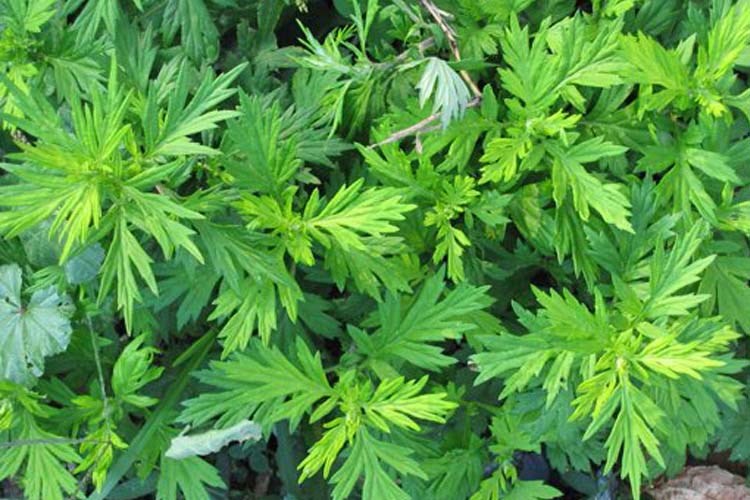
The first post in Herb Witch in Training describes my first foray into edible weed identification at age 13. To repeat: The plant is a common lawn weed that grows relatively tall with slim elliptical smooth-edge leaves that sprout the length of the stalk. Homeowners really don't like it because it is one of those weeds that literally sticks out like a sore thumb. Here's a shot of a side yard full of them. It looks a bit like Goldenrod but there's no flowering and it stands upright its full length. This herb witch trainee needs a more experienced naturalist to confirm the family and genus. Once the name is known, then its nutritional and medicinal values will be described.
Lamb's Quarter (Chenopodium berlandieri) are the plants located in the foreground of this picture (there are two dandelions just behind it). Also called Pitseed Goosefoot, Lamb's Quarter is a green

plant with triangular leaves with white dust on a few of them. It is cultivated in Mexico for produce. It is a good source of Beta-carotene, Vitamin C, Calcium, Potassium, Iron, trace minerals, the B complex, and fiber. In fact, it is more nutrient-dense than spinach. Go tell Popeye about it. Lamb's quarter is tasty raw in salads or steamed like spinach. Being a part of the Amaranthacea family, the seeds of Lamb's quarter may be used as a cereal. This plant can be found in tree pits, lawns, vacant lots, and fields. Lamb's quarter may be found in close proximity to Mugwort, a medicinal plant.
A bit more about Mugwort (Artemesia vulgaris): without foreknowledge, I occasionally burned dried

Mugwort on charcoal and found it to be quite soothing. I re-investigated its properties to be reminded that it is a nervine and it relieves insomnia. Some people gather many stalks of it and let them dry completely. Once dry, the Mugwort is folded into to 6-inch bundles and tied with yarn or natural fiber twine for smudging. Other Mugwort fans make a strong tea of it, making 32-oz batches of it to be poured in bath water. The medicinal plant is good for liver disorders and digestive conditions where it is drunk before and after eating. Think of that: drinking it, inhaling it, and/or bathing in it offers a remedy. As mentioned before, I call it the "Woman's Friend".

Mushrooms are a favorite for many people. They fall into either the saprotropic (live and feed on dead organic matter), mucorrhizal (attaching harmoniously to plant's roots), parasitic (a small group that live off live organisms), or endophytic (living inside living organisms without causing disease) category. Please remember that they are fungi (sing. Fungus). Yes, with good promotion, we are eating fungus and paying quite a bit for Oyster mushrooms, Shitake mushrooms, and Truffle mushrooms. The shot of this unidentified fungus growing from a tree stump is shown to reveal the great diversity of this vegetation.
Not all have caps, stems, and gills within the caps. The reader is advised not to eat this fungus. The edible mushrooms are numerous (e.g., cremini, portabello, enoki, truffles, shitake, etc). Mushrooms are a source of Riboflavin, Niacin, Pantothenic acid, Phosphorus, Zinc, and small quantities of Carbohydrates and Protein. Chinese medicine includes various mushrooms. The plant is dried for storage and later boiled. Both the body and juice are considered very healing.

To close my discoveries on a brief walk in my neighborhood is this member of the dock family, Red-Veined Dock (Rumex sanguineus) which is part of the Buckwheat family. Red-veined dock is edible and medicinal. The leaves may be tossed raw into salads or steamed. It becomes bitter with age. While many people avoid bitter foods, they are beneficial to us in that bitters reduce the craving for sugar. The root is astringent. An infusion of it, i.e., the boiled water is poured over the plant is good for the treatment of bleeding and a decoction, i.e., the plant boiled in water, treats several skin diseases. Like many plants highlighted thus far, it contains a high amount of oxalic acid. With so many plants containing oxalic acid, it's a wonder whether it serves as a defense against insects dining on them.



.png;w=120;h=80;mode=crop)
